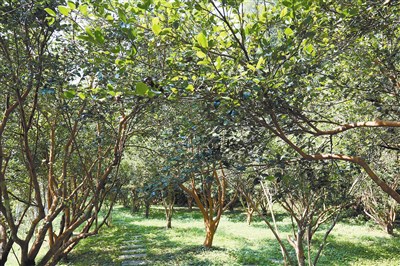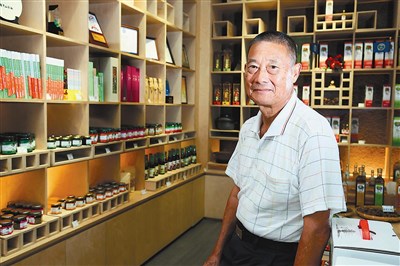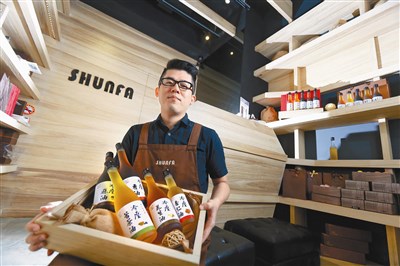 油茶樹既能生產苦茶油,亦能守護大地,因此農糧署大力鼓吹農民將檳榔廢園轉作油茶。圖/林格立
油茶樹既能生產苦茶油,亦能守護大地,因此農糧署大力鼓吹農民將檳榔廢園轉作油茶。圖/林格立
 金椿茶油工坊創辦人陳福康由原料批發起家,如今從油茶栽培、加工、銷售,到研發副產品,發展成一條龍的苦茶油產業。圖/林格立
金椿茶油工坊創辦人陳福康由原料批發起家,如今從油茶栽培、加工、銷售,到研發副產品,發展成一條龍的苦茶油產業。圖/林格立
 「林記順發」油行已飄香半世紀,第三代經營者林士發插旗台北開店,走品牌創新之路,成績亮眼。圖/林旻萱
「林記順發」油行已飄香半世紀,第三代經營者林士發插旗台北開店,走品牌創新之路,成績亮眼。圖/林旻萱
文/張瓊方 圖/林格立 (摘錄轉載自105年8月《台灣光華雜誌》全文請參考http://www.taiwan-panorama.com/)
提 要
開門七件事,柴米油鹽醬醋茶。現代人已不太燒柴,也有些人選擇不吃米飯,但幾乎沒有人能不吃油。為求食得安心,有人不惜重本,改吃價位較高的進口橄欖油,也有人開始回頭尋找台灣在地的鮮榨好油。有「東方橄欖油」之稱的苦茶油,因單元不飽和脂肪酸的含量高,更因此一夕翻紅,身價水漲船高。
被譽為「超級食物」、「健康好油」的苦茶油,究竟有什麼過人之處?
Shunfa Oil was established in 1963, first as a contract oil presser. Marketing manager Joseph Lin, a member of the family firm's third generation, began production of Shunfa's own brand of extra virgin cooking oils several years ago. He has commissioned the design of glass bottles and gift boxes and has opened a store in a bustling retail location in Taipei's Zhong shan District. Last year Lin took his cold-pressed camellia oil to a Monde Selection competition in Belgium, and won a bronze medal.
Golden Flower Tea Oil in Miaoli's Sanwan takes a more mass-market approach. CEO Chen Fu-kang started out 30-some years ago as a wholesaler of the camellia seeds from which camellia oil—a.k.a. tea seed oil—is made. In 2000, Golden Flower began working as an oil presser and supplier for the Leezen organic grocery chain. Because market demand was so high, in 2006 it launched its own brand.
Once the oil adulteration scandal hit, Shunfa's business took off. Golden Flower likewise ramped up production, so that today it is Taiwan's largest producer of camellia oil.
Chinese have been using camellia oil for more than 2000 years. Yet today most people’s impression of the oil stops at adding it to thin noodle dishes. Many think that camellia oil has a bitter flavor ( it's commonly called "bitter tea oil" in Chinese) and should be left to those with sensitive stomachs or to women who have just given birth.
Is camellia oil necessarily bitter? In truth, no. "Not only is good camellia oil not bitter in taste, it actually has a delicate and pleasant aroma," says Susan Huang, Golden Flower's assistant general manager.
Setting aside the subjective matter of fragrance, camellia oil is undoubtedly a good oil. According to Lin, it contains 83% monounsaturated fatty acids, surpassing the 73% of olive oil. And it's loaded with other healthy components, such as tea polyphenols, chlorophyll, and vitamin E.
Lin holds that camellia oil is simply more nutritious than olive oil. Monounsaturated fats can lower bad cholesterol and raise good cholesterol, helping to protect blood vessels.
What people find particularly surprising is that camellia oil's fats are stable, with a smoke point of 252°C. That compares to 160°C for common olive oil and 216°C for grapeseed oil. The high smoke point makes camellia oil suited to all manner of cooking methods: sautéing, boiling, frying or deep-frying.
There are two basic types of oil-tea camellias in Taiwan: those planted for the oil alone, which include both large-and small-fruited varieties (Camellia oleifera and Camellia tenuifolia); and a second type, Camellia sinensis, whose leaves are also harvested for tea.
Producing camellia oil is a simple process. The harvested seeds are first sun-dried for ten days, after which the outer layer of the shell will naturally separate from the seed. Then a shelling machine is used to remove the second layer. Before pressing the oil, the seeds are crushed into a powder, which is placed into a wooden pail to be sterilized by steaming. The wet powder is then removed and spread out to cool and dry before being formed into layered cakes, which are placed under 200 to 300 kilograms of pressure to extract their oil.
"Camellia oil, sesame oil and peanut oil are all seed oils, while olive oil is the oil of a fruit's flesh," points out Huang. The biggest difference is that with seed oils you've got to first heat the seeds—both to kill germs and to help the seeds stick together, making it easier to extract the oils.
Based on figures published in 2014, Taiwan currently produces about 1 million kg of camellia oil per year, mostly in Chiayi, Nantou and Miaoli. Since Taiwan doesn't produce nearly enough camellia seed itself, more than 90% has to be imported.
In recent years, in order to raise the percentage of food oil products produced domestically and to ensure the safety of food oils, the Taiwan Forestry Research Institute has assembled a camellia oil research team from staff at the Tea Research and Extension Station and the Tainan District Agricultural Research and Extension Station. The team is working on breeding new and improved varieties and advancing growing techniques, so as to improve quality and increase yields.
Thanks to the efforts of many, fresh camellia oil is not only protecting the health of those who consume it, but is also helping to nourish Mother Earth.
解 說
位在北港朝天宮附近的「林記順發」油行,成立於一九六三年,早期由代工榨油起家,近年第三代林士發出任客戶經理一職,開始走創新品牌路線,不但玻璃油瓶設計新穎,禮盒包裝講究,還在台北精華地段中山區插旗開店。去年林士發將自家冷壓初榨苦茶油送去比利時參加世界油品評鑑,榮獲銅牌獎殊榮。
另一家位於苗栗三灣的金椿茶油工坊走的則是普及路線。董事長陳福康三十幾年前從經營苦茶籽原料批發起家,二○○○年起為有機商店「里仁」做代工,後因市場需求日殷,於是在二○○六年自創品牌。
一場食油風暴,走過半世紀的「林記順發」生意不降反升;苗栗三灣的金椿茶油工坊產量也逆勢成長,已成為台灣規模最大的苦茶油坊。
中國人食用苦茶油已超過兩千年的歷史,不但老祖宗視其為「神油」,聯合國農糧組織也把苦茶油列入重點推廣的健康食油行列。不過,如今大家對苦茶油的印象,多只停留在「拌麵線」階段,也有人認為苦茶油有苦味,是胃不好、或坐月子的產婦才需要吃。
苦茶油一定苦口嗎?其實不然。「好的苦茶油不但不會苦口,還有一股清香。」金椿茶油工坊副總經理黃捷纓如是說。
撇開人言人殊的氣味不論,苦茶油確是好油。林士發指出,苦茶油單元不飽和脂肪酸含量高達百分之八十三,甚至超越橄欖油的百分之七十三。此外,它還含有茶多酚、葉綠素、天然維生素E等營養成分。
林士發指出,苦茶油的營養價值比橄欖油更高。其單元不飽和脂肪酸可降低壞膽固醇、提高好膽固醇,具有保護心血管的功效。
更令人驚豔的是,苦茶油的油脂安定,黃捷纓表示,苦茶油發煙點(油加熱生煙的最低溫度)可達攝氏二百五十二度,比一般橄欖油一百六十度、葡萄籽油二百一十六度還要高。舉凡煎、煮、炒、炸樣樣皆可。
她以金椿生產的三款茶油為例,「茶葉綠(茶籽油)比較香,可以拿來炒蛋、煎蛋、煎魚;紅花大茶油則任何料理都適用;金花小茶油因為品種較稀有,榨油溫度較低,保留更多的葉綠素和茶多酚,可以生飲、涼拌,甚至用來做護膚美容保養品。」
台灣茶油分兩大類,一種取自專門採籽榨油的油茶樹(分大果油茶、小果油茶兩種),榨籽取油即為苦茶油;另一類來自既可採茶亦能榨油的茶樹,成品稱為茶籽油。
苦茶油的製程非常簡單。採收的油茶籽先曝晒十天左右,油茶籽第一層殼會自動分離,再使用脫殼機將第二層殼脫除。榨油前要將油茶籽碾成粉狀,置入木桶中蒸熟殺菌,取出攪散、吹涼、吹乾後壓模做成餅狀,再層層堆疊,以二、三百公斤的壓力將油壓出來。
「苦茶油、麻油、花生油是種子油,橄欖油是果肉油。」黃捷纓指出,其間最大的差別在於,種子榨油要先受熱,一來殺菌,二來使其產生黏性,油脂才容易被逼出來。
苦茶油是在地現榨好油,雖然風味不見得人人喜歡,但在追求健康的前提下,接受度日高。只是,台灣苦茶籽的產量供不應求,九成以上都需要仰賴進口。
根據農委會二○一四年年報,台灣目前苦茶油年產量約一百萬六千餘公斤,以嘉義、南投、苗栗為大宗。
在各方努力下,在地的鮮榨苦茶油,不但能守護大家的健康,也能守護這塊滋養我們的大地。